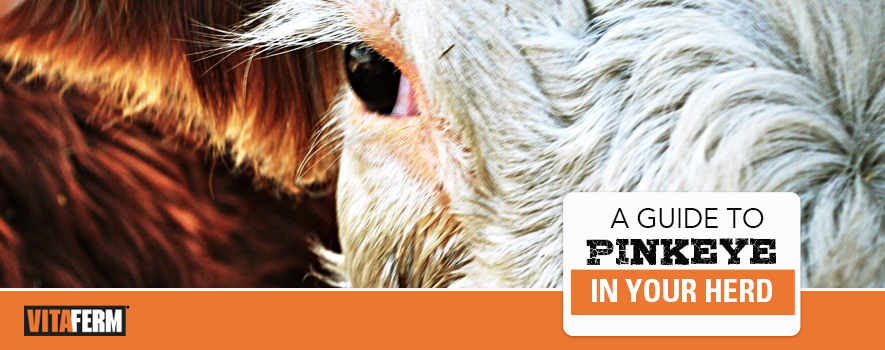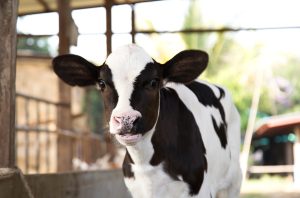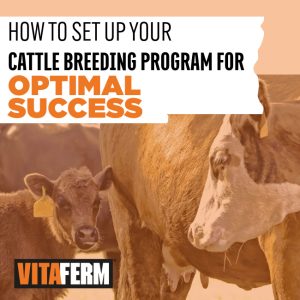Pinkeye is a highly contagious infectious disease that impacts cattle across the world. According to a University of Nebraska Veterinary website, pinkeye costs U.S. beef producers between $150-300 million per year. Economic hits can come by way of decreased gain and decreased milk production, therefore decreasing the overall value of your cattle, as well as an increase in treatment costs.
Don’t let pinkeye attack your herd, costing you performance and health. Especially prevalent through the spring, summer and fall, pinkeye can be a big detriment, although not usually fatal. With proper control and management, you can help prevent pinkeye in your herd.
What is Pinkeye?
Pinkeye is often caused by the bacteria Moraxella bovis (M. bovis). However, other organisms have been isolated from eyes with infections resembling pinkeye. It is unclear if those organisms are primary pathogens or opportunistic, secondary invaders. Pinkeye is caused by a combination of factors. Other factors instrumental in causing eye irritation, thereby allowing for invasion of M. bovis and subsequent disease, are excessive ultraviolet light like sunlight, environmental vectors including wind, dust, seed, pollen and flies and a marginal nutrition program.
Watering eyes are typically the first signs of pinkeye. Once the animal’s eyes start watering, you will likely notice the animal start squinting or closing its eyes regularly to shield the sun out. Pinkeye will usually last up to two weeks and has four distinct stages.
During stage one, cattle have excessive tearing and increased sensitivity to light. They blink frequently and there is redness along the eyelids. Cattle seek shade, which decreases their grazing time. Pain associated with pinkeye also decreases their feed intake. Stage one progresses to a small ulcer in the center of the cornea which appears as a small white spot.
During the transition to stage two, the clinical signs of stage one continue, but the ulcer spreads across the cornea. As inflammation occurs, the cornea grows increasingly cloudy. Some of the dark color of the iris can still be seen. Blood vessels from the outside portion of the cornea begin to grow across the cornea to help with healing. These blood vessels make the cornea appear pink, which is how the disease received its name.
In stage three, the ulcer covers most of the cornea and the inflammation continues to spread into the inner parts of the eye. The inside of the eye fills with fibrin, a pus-like substance that gives the eye a yellow appearance versus the typical brown appearance.
During the final stage, the ulcer extends completely through the cornea, and the iris may protrude through the ulcer. The iris will become stuck in the cornea even after healing. This may lead to glaucoma or persistent swelling of the eye. This eye will be partially or completely blind. The eye may completely rupture, and will develop a shrunken appearance or enlarge if glaucoma (increased eye pressure) is present.
An Ounce of Prevention
The best way to stop the spread of this nuisance disease is to control it through the combination of a good management and nutrition program. Eliminate any carrier animals from the herd since the disease is so easily spread through nasal and ocular discharge, through the air, from infected equipment and from fly transport.
Speaking of flies, make sure you control all flies: horn, face and stable, using various methods that work for your operation. Generally speaking, a combination of two fly control methods work the best for combating flies. You can use a spray, dust bags, ear tags, a feed-through mineral with IGR and a natural mineral solution that contains garlic like VitaFerm® HEAT®. VitaFerm HEAT contains garlic, to deter insects. It also contains a combination of plant extracts, research-proven to lower body temperature to help with performance in extreme temperatures and fescue situations. It also includes Vitamin A, organic zinc and copper to help prevent hoof challenges as well as pinkeye. Finally, as with all VitaFerm products, it contains Amaferm®, a precision-based prebiotic, research-proven to impact intake, digestion and absorption, so your animals will get the most possible nutrients from their feed.
Reduce any eye irritants as much as you can, including dust, wind, pollen, direct sunlight and any nuisance weeds. Although wind, dust and pollen often work together, if you provide your animals some time of shade and/or wind break, that can help eliminate some dirt and sun from getting directly in your animals’ eyes. You can also help eliminate the dust by reducing overcrowding in dry lots or bunks where you feed.
Finally, if you do have cattle that show signs of pinkeye, segregate them immediately from the rest of the herd, in hopes of eliminating future spreading.
Treatment Time
You will want to start treating pinkeye at the first signs, not only to provide comfort to the animal, but to also help prevent the spread of disease. There are various treatment methods available including topical sprays, ointments and powders, long acting tetracyclines can be given through a shot, and you can inject penicillin and dexamethasone into the bulbar conjunctiva, the thin membrane that covers the white portion of the eye. Also, consider an eye patch or suturing the third eyelid over the eye, or suturing the eyelids shut to add comfort to the eye by reducing the sunlight and keeping other irritants out. Anytime you consider injections or suturing around the eye, be sure to have a veterinarian or someone trained in this come do the procedure, as you don’t want to cause more harm to the livestock. As always, consult your veterinarian for the best treatment plan for your cattle in your area.
Pinkeye is a cattle disease that is easy to get and easy to spread within your herd. However, with some good nutrition and a management plan, it can be kept under control, especially if you already have a good fly control plan in place. Work ahead and work smart so you don’t have to treat pinkeye in your herd.



